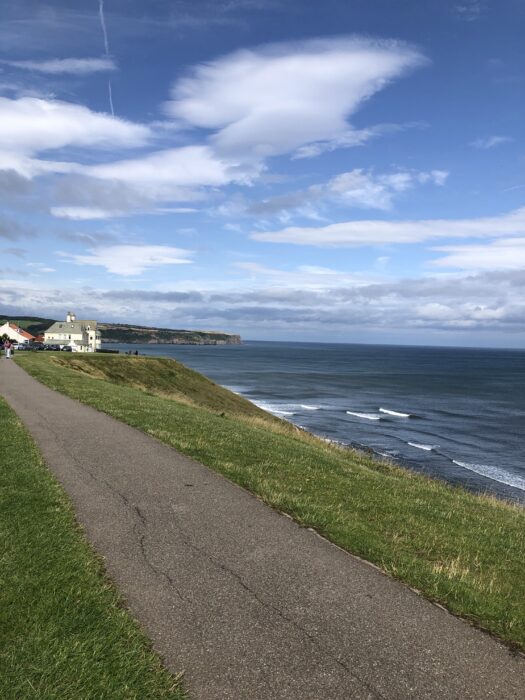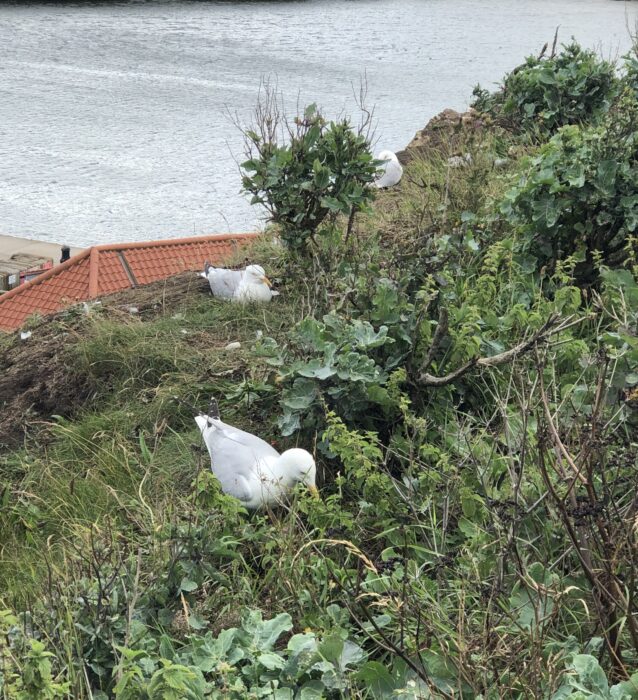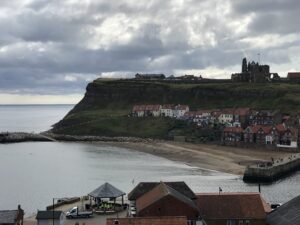
There’s one last sight to see before crossing the Swing Bridge to the West Side of Whitby. If you take a left before crossing the bridge, you’ll be on Grape Lane, a narrow thoroughfare of some interest.
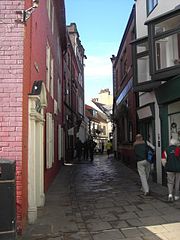
Some say Grape Lane was known of Grope Lane, a place where prostitutes plied their trade among the sailors and shipbuilders who frequented the area. In the 18th century, Whitby was an important port for herring fishermen who followed shoals of herring down the east coast of England starting at the Shetland Islands in late winter and completing the cycle off East Anglia the following fall. In 1836, about 400 vessels engaged in the Yorkshire herring industry, many stopping in Whitby harbor.
The 18th century also saw the birth of the Whitby Whaling Trade. In 1753, several merchants formed the Whitby Whaling Company with two ships. The fleet grew to 55 ships out of Whitby. It’s estimated that the industry harvested 2,761 whales, 55 polar bears, and 25,000 seals.
Fishing and whaling encouraged an extensive shipbuilding industry, as did alum processing which requires a large amount of coal. The coal came from Durham. The specially built colliers had flat bottoms. Whitby had 11 shipyards and built 11,754 tons of shipping in 1790.

Captain James Cook, famous for his exploits in the Pacific, served his 3-year seaman’s apprenticeship under Captain John Walker. In 1755 Cook joined the Royal Navy. Walker’s house was on Grape Lane, and is today the Captain Cook Memorial Museum, an example of 17th Century construction as well as Cook’s naval career.

On the other side of the River Esk, there is a replica of the HMS Endeavour, which Cook commanded on his first Pacific voyage.
The West Cliff towers above the the shoreline, but the good news is there’s a direct road called the Khyber Pass, built into the cliff. George Hudson, an entrepreneur and Whitby investor, built the road to provide access to the West Cliff estates he owned. Access is one way, going up. The Royal Hotel with its sweeping view of the East Headland is at the top.
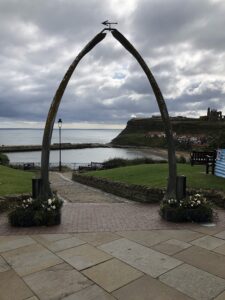
Nearby are two maritime tributes. One is the famous Whalebone Arch, first erected in 1853. During the whaling boom, successful ships attached a whale’s jaw bones to the mast to show the ship was full. The bones for the present arch came from Alaska in 2003.
Captain Cook’s Memorial went up in 1912. There he stands, forever looking out to sea, with an occasional seagull on his head.
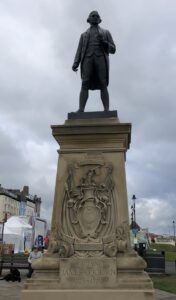
Whitby had always looked to the sea for its livelihood, but in 1839 the Whitby and Pickering Railway connected Whitby first to Pickering and then on to York. Initially, it was a single-track horse-worked railway with a distance of 24 miles. At Pickering, passengers had to take a stage coach the rest of the way to York.
But in 1845, the Whitby and Pickering joined the York and North Midland Railway. The connection was now a modern, double-track steam railway. Tourism was soon to follow.
Money once invested in shipping was diverted into the construction of large boarding houses and hotels on the West Cliff. Shipowners who held land outside the town, sold it to developers. One of the investors was George Hudson, briefly known as the Railway King. He formed a building company to construct a Royal Crescent. It was half complete when the company went bankrupt.
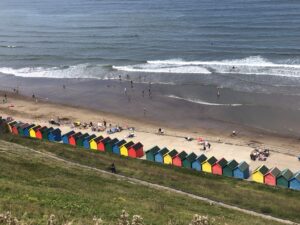
Today the hotels and guest houses continue in popularity. But it’s a long way down from the top of the cliff to the beach, and the weather is less than ideal. Enter the well-known colorful beach huts that rent for about £600 a year. There’s also an elevator built into the cliff, so beachgoers can avoid the climb.
The Western Headland is also part of the Cleveland Way that circles the North York Moors National Park from Helmsley to Filey. I declined to hike the entire 109 miles, but did enjoy a short jaunt.
🦀🦀🦀
Grape Lane by Darren Haddock.
Captain Cook Memorial Museum by aude.
Captain James Cook by Thomas Wright.
All Other Photos by Author.

Sandra Wagner-Wright holds the doctoral degree in history and taught women’s and global history at the University of Hawai`i. Sandra travels for her research, most recently to Salem, Massachusetts, the setting of her new Salem Stories series. She also enjoys traveling for new experiences. Recent trips include Antarctica and a river cruise on the Rhine from Amsterdam to Basel.
Sandra particularly likes writing about strong women who make a difference. She lives in Hilo, Hawai`i with her family and writes a blog relating to history, travel, and the idiosyncrasies of life.

